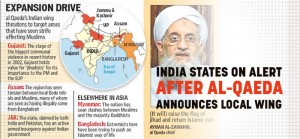Contemporary Effects and Situations & Impacts
2001- September 11 and al Qaeda Today
On September 11, 2001 al Qaeda executed its most devastating attack against the United States, killing nearly 3,000 civilians. The U.S. military response in Afghanistan crippled al Qaeda significantly. Without the protection of the Taliban, bin Laden went into hiding and al Qaeda became far more decentralized. However, a recent National Intelligence Estimate report shows that al Qaeda is gaining strength again, and has significantly rebuilt itself despite U.S. efforts.
Al Qaeda’s Resurgence: A Threat to U.S. Interests
Al Qaeda currently has many branches operating around the world. The Diplomat News most recently announced on September 23rd that the leader of al Qaeda, Ayman al Zawahiri, has established of a new branch: al Qaeda in the Indian Subcontinent (AQIS). Bruce Hoffman from the Washington Institute believes that internally, al-Qaeda’s core has long been made up of disenfranchised and marginalized youths and this constituency remains a prime target for the organization’s recruitment. However analysts are portraying this administrative re-shuffling as a desperate response to the existential challenges posed by the emerging ISIS organization in northwestern Iraq and Eastern Syria who has seemingly rendered al Qaeda impotent and irrelevant in the eyes of potential recruits, especially valuable Western ones.
Former deputy assistant secretary of defense for Afghanistan, Pakistan and Central Asia, David Sedney, said this June “We have never been on a path to strategically defeat al Qaeda. All we’ve been able to do is suppress some of its tactical abilities. But strategically, we have never had an effective way of taking it on. That’s why it continues to mutate, adapt and evolve to get stronger,”
Many Americans seem to think Al Qaeda is no longer a threat since the death of Osama bin Ladin, however experts say it’s a fight about ideology rather than a person or group. Consequently, believers in this ideology who join al Qaeda are growing. Experts say al Qaeda looks more like a spider web stringing together like-minded groups, rather than a wheel with spokes.
Tom Joscelyn, a senior fellow at the Foundation for Defense of Democracies and senior editor of The Long War Journal, a website that tracks how al-Qaida and its affiliates operate around the globe, said “This shows, to my mind, that we’re not dealing with this sort of discrete core entity in Pakistan and Afghanistan that can be droned to death, but in fact an international network that poses a lot graver challenges,”.






 This is the default footer layout. You can easily add or remove columns in the footer.
This is the default footer layout. You can easily add or remove columns in the footer.
Recent Comments